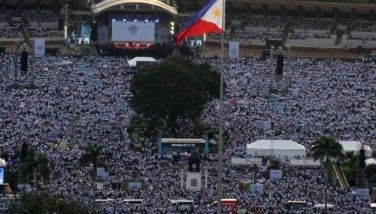The Manila Bay crisis

The recent photos taken of Manila Bay showed the beautiful sunset and happy people strolling by the bay and a few even bold enough to take a dip in the seemingly clean waters. But the real clean up hasn’t even started. Let’s not get too excited over this initial feat. There’s still a lot of work to be done. Remember Manila Bay waters is worst than Boracay.
Let us back track a bit and see how the Manila Bay crisis came to be. In 2008, the Supreme Court initially gave the Executive Branch, led by the Department of Environment and Natural Resources (DENR) 10 years to rehabilitate the bay. Then on February 15, 2011, another order was issued by the high court mandating the completion of the cleanup by June 30, 2011. In the previous administration, a revised plan was drawn up, but unfortunately they never got around to achieving anything significant in its so-called “Operational Plan for the Manila Bay Coastal Strategy.” To sum it all up, nothing was really done to the Manila Bay problem.
It must be noted that the Manila Bay area covers 8 provinces and 178 local governments in 3 regions, namely: National Capital Region (NCR), Central Luzon, and Calabarzon. Its drainage area covers 1,994 kilometers and its coastline stretches some 190 kilometers. Manila Bay also has 17 principal river systems draining into it, namely: Angat River, Bocaue River, Sta. Maria River, Marilao River, Meycauayan, Meycauayan-Valenzuela River, Pasig River, Parañaque River, Imus River, Ylang-ylang River, Rio Grande, Cañas River, Obando River, Navotas-Malabon-Tinajeros-Tullahan River, Talisay River, Guagua River, and Pampanga River. So, you can just imagine the amount of filth that flows from these rivers to Manila Bay. Added to this is the non-existent sewerage system.
Now, there are allegations that both Manila Water and Maynilad have failed to provide sewerage system in the past 10 years.
It has been 11 years since the Supreme Court’s order. The government is finally doing something about it. News reports last week said that 5 establishments along Manila Bay including Max’s Restaurant UN Orosa, HengFeng Kitchenette, Jollibee Macapagal Biopolis, Lamer Catering, and Nihon Bashitei Japanese Food were served “cease and desist” order by the Laguna Lake Development Authority (LLDA) for water pollution.
It was also mentioned in the same report that Aloha Hotel, Sarmiti Food Corp (Shawarma Snack Center) and Oriz Auto Leasing Philippines Corp were asked to explain their violations within a 15-day period. Notices of violations for water pollution will also be issued to Heritage Condominium Corp, Ma. Natividad Building, Marina Square Properties Inc (Hyatt Hotel and Casino Manila), Cultural Center of the Philippines (main building and production design center), Federal Land Inc (The New Blue Wave), First Marbella Condominium Association Inc., Gold Quest Premiere Resources Inc (The Biopolis), Harrison Lodge, Libertad Tourist Development Inc (Halina Lodge/Hotel), OWWA Building, and Wellcross Freight Corp.
We should be glad that finally we have a DENR Secretary who is trying to get things done. But wait, like I said earlier, let’s not get too excited. There are still things that need to be worked out by the government to ensure the sustainability of the project. While Secretary Cimatu is at it, he should make sure his officers will do things the right way. There should be a well studied plan with professional consultants. The agency has not made any mention of the Manila Bay Sustainable Development Master Plan I wrote about a few months back. I did say that the pollution of Manila Bay is far worse than Boracay (1000 times).
Just like Boracay, Manila Bay won’t be in a crisis state, if only the responsible agencies (DENR, LGUs etc.) have consistently and strictly carried out their mandate. Where are the project management skills of these officials? If they are really doing their regular monitoring and evaluation functions, the crisis could have been avoided and corrective actions could have been done earlier.
Why only punish the establishments when the agencies failed in the first place. Till now, no actions have been taken to fire the inept government officials. The government is always good at finding solutions when it has already reached the crisis stage.
What about the proposed Manila Bay Development Authority (MBDA) that will handle the rehabilitation and management of the bay area? This is meant to be a permanent body that will be created by law. The group Manila Bay Initiative (MBI) with my friend Rick Ramos as convenor is now working on the bill. They need the MBDA for focus and continuity.
Several agencies and private organizations would want to see this project work. The Philippine Coast Guard alongside its Coast Guard Auxiliary has always been at the forefront of the Battle for Manila Bay. It has silently fulfilled its mandate of marine environmental protection without much fanfare. It has conducted countless symposia, information dissemination, and organizing the youth in coastal clean-ups, on a monthly basis. It has collected empirical data over the years that have been used to enact legislation against the use of plastic bags, straws and take-away styrofoam containers. It has also helped collect irrefutable evidence against shipping lines and land-based factories and establishments that do not comply with maritime laws on the waste management.
Last week, President Duterte created a task force that would speed up the rehabilitation and restoration of Manila Bay through Administrative Order 16. Environment Secretary Roy Cimatu will chair the Manila Bay Task Force, while Tourism Secretary Bernadette Puyat and Interior and Local Government Secretary Eduardo Año will serve as vice chairs.
Its members include chiefs of Department of Public Works and Highways, Department of Health, Department of Agriculture, Housing and Urban Development Coordinating Council, Metro Manila Development Authority, Pasig River Rehabilitation Commission, Local Water Utilities Administration, Manila Waterworks and Sewerage System, Philippine National Police Maritime Group, Philippine Coast Guard, Philippine Ports Authority, as well as representatives of the Manila Water Company Inc. and Maynilad Water Services.
The task force is expected to enforce relevant laws to ensure the rehabilitation and conservation of Manila Bay, improve its water quality, implement a comprehensive plan for massive relocation of informal settler families, facilitate information drive on Manila Bay clean-up, among others.
Local government units in Metro Manila, especially those along Manila Bay, and governors in the provinces of Bataan, Pampanga, Bulacan and Cavite were given orders to ensure the implementation of critical environmental laws and other relevant laws. President Duterte said, “The convergence of national government agencies and LGUs in the Manila Bay region and the active participation of private and public stakeholders are necessary to facilitate the robust and integrated implementation of all rehabilitation and restoration efforts at the Manila Bay.”
Once the rehabilitation of Manila Bay is completed, how does the government intend to measure the impact and success of the intervention? How about the sustainability issue? To monitor its progress and success, clear and specific indicators are needed (e.g. level of coliform, number of informal settlers who returned to Manila Bay after relocation, number of barangays and officials who continue defying and ignoring ordinances, number of arrests made on littering, volume of trash collected etc.).
The Battle for Manila Bay is a “whole nation” approach. No one department or LGU can lay claim to the liberation of Manila Bay. It has to be every one of us contributing to its preservation. The current state of the Bay is only the first phase of a long-drawn development plan that does not and should not end with the current administration.
Are we celebrating prematurely? Wait till another typhoon comes and see if the trash won’t flood Manila Bay again.
- Latest
- Trending



























